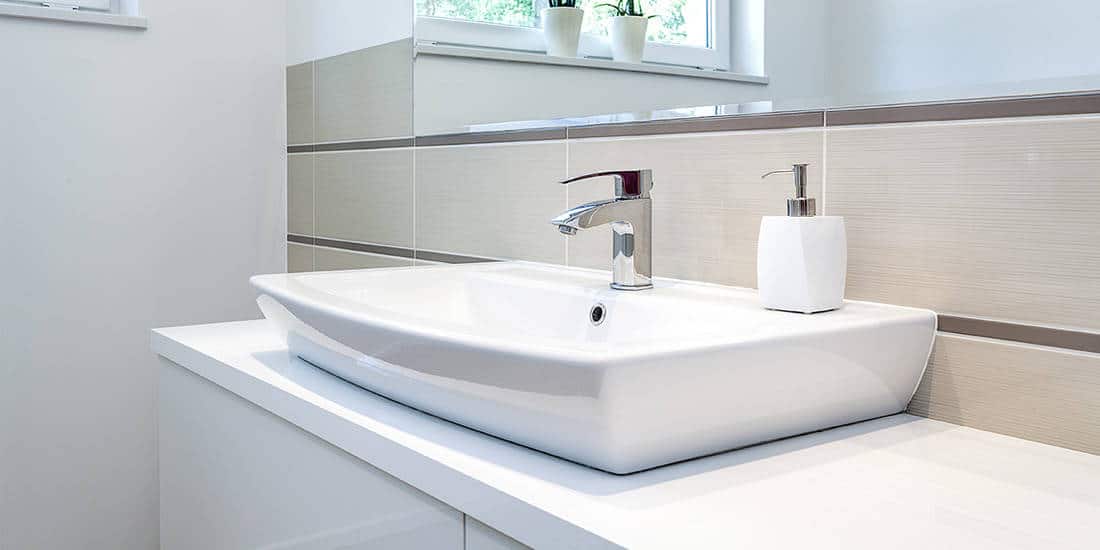Discover Your Ideal Bathroom Basin: Understanding Types, Materials, Installation Methods, and More
Stepping into the bathroom design world can be overwhelming with the sheer variety of styles, designs, and options. Whether you’re renovating an existing bathroom or starting from scratch, the right bathroom basin can greatly enhance your space, balancing functionality and aesthetics.
This Basin Buyers Guide is your stepping stone to exploring the wide range of available bathroom sinks and basin brands, understanding different materials, basin types, installation methods, and the latest trends. So, let’s discuss the selection of basins and help you choose your perfect wash basin from renowned brands like Armitage Shanks, Villeroy & Boch, and Roper Rhodes.
Introduction: The Importance of Selecting the Right Bathroom Basin
The bathroom basin is no longer just a functional necessity. Today, it’s a statement piece reflecting your style and bathroom design. When selecting a basin sink, factors like size, shape, material, and installation methods come into play. Choosing the right basin mixer taps and other accessories can also enhance the look of your basin.
In addition to the aesthetic aspect, selecting the right bathroom basin is crucial for practical reasons. The size and shape of the basin should be considered based on the available space in your bathroom and your personal needs. A corner or cloakroom basin may be suitable for a compact bathroom. In contrast, a duo basin may be more convenient for a shared bathroom.
The material of the basin should be durable and easy to clean, as it will be frequently used and exposed to water and cleaning products. The installation method should also be considered, as different basins require different plumbing arrangements. Choosing the right bathroom basin is essential for creating a functional and visually appealing bathroom space. TOC
Different Types of Bathroom Basins: An Overview
Exploring the huge variety of bathroom basins available, from traditional designs to contemporary styles, can give you a wider perspective to choose from. And your choice of bathroom sinks can either enhance the overall bathroom aesthetic or break it. But the good thing is, with the vast range out there, there is no lack of options that will suit a variety of spaces. So take your time and make a list of preferred features to avoid an impulsive decision.
Pedestal Sinks: Elegance and Simplicity
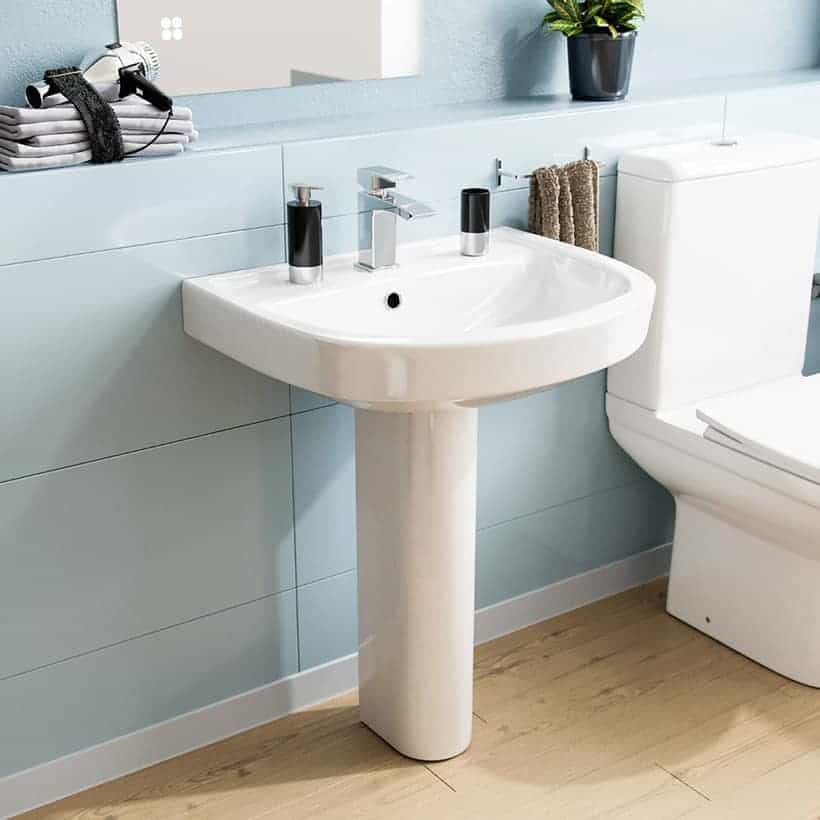
These stand-alone on a single pedestal basin convey a classic, clean look. Most ideal for smaller bathrooms, they help to save valuable floor space.
In addition to their space-saving benefits, pedestal sinks offer a timeless class to any contemporary bathroom. Their sleek and simple design creates a sense of sophistication and refinement. Whether your bathroom is modern or traditional, a pedestal sink can seamlessly blend in and enhance the overall aesthetic.
The lack of bulky cabinets or countertops also gives the illusion of a larger, more open space, making the bathroom feel brighter and more inviting. With their combination of functionality and style, pedestal sinks are popular for homeowners looking to create a chic and minimalistic bathroom design. TOC
Undermount Basins: Sleek and Modern
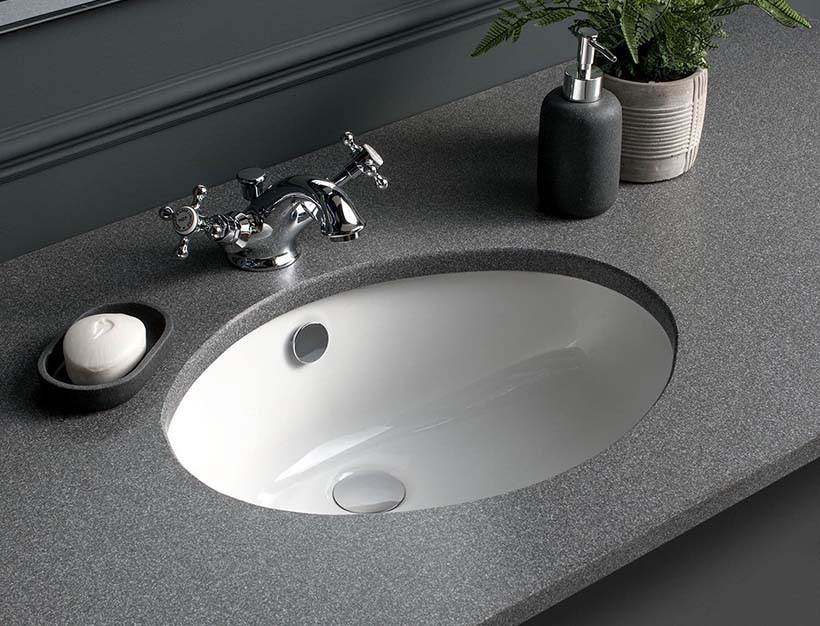
Due to its streamlined look that sunk into the countertop with no rim showing, the undermount sinks are a preferred choice not only by minimalists but also well-loved by the fastidious lot. They’re super easy to clean, making them a practical choice for busy city dwellers.
In addition to their sleek appearance and easy-to-clean design, undermount basins also provide a sense of spaciousness to the bathroom. By being installed underneath the countertop, they create an uninterrupted surface that visually expands the space. This makes undermount basins particularly popular in smaller bathrooms or powder rooms where maximising the perceived size is essential.
Furthermore, their seamless integration with the countertop allows for a more cohesive design, making them a popular choice for modern and minimalist styles for any main bathroom or cloakroom.
Vessel Sinks: Bold and Artistic

Unlike the common inset basins, the vessel sink commands attention for its unique installation, placing it directly on the countertop. These surface-mount washbowls are versatile and available in various materials, shapes, and designs to suit different tastes.
One of the unique aspects of vessel sinks is their artistic and bold design. Unlike traditional undermount or drop-in sinks, vessel sinks are meant to be a focal point in the bathroom or kitchen. With their elevated position, they create a sense of elegance and sophistication.
Vessel sinks come in various artistic designs, from sleek and modern to intricate and ornate. If your bathroom feels a tad uninspiring, introducing a vessel basin can infuse a dramatic flair. However, to accommodate a vessel basin for installation, you’ll need to modify or change the countertop of your vanity unit.
Whether it’s a vibrant glass vessel sink or a handcrafted ceramic bowl, these designer basins are sure to make a statement and elevate the overall aesthetic of any bathroom.
Wall-mounted Basins: Space Savers
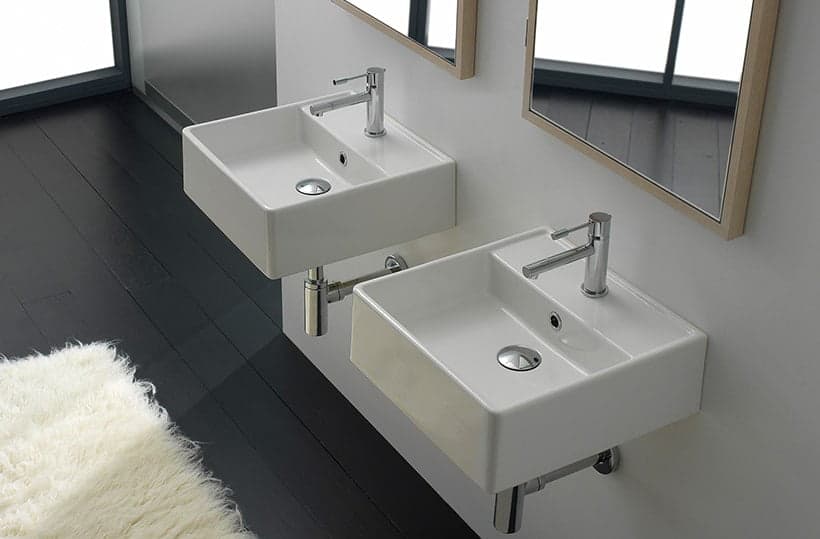
As the name suggests, these basins are attached directly to the wall offering the advantage of freeing up floor and counter space. They can give your bathroom a neat, modern vibe and are an excellent solution for compact spaces.
Why settle for a standard sink when you can have the versatility and convenience of a wall-mounted basin? Not only does it save space, but it also offers the added benefit of height freedom. This means you can easily customise the basin to your preferred level, making it a practical and comfortable choice for any bathroom.
Furthermore, wall-mounted basins are relatively easy to install and maintain, as they do not require the same level of plumbing work as traditional basins. Overall, these space-saving fixtures provide both functionality and style to any bathroom.
Integrated Sinks: Seamless Design
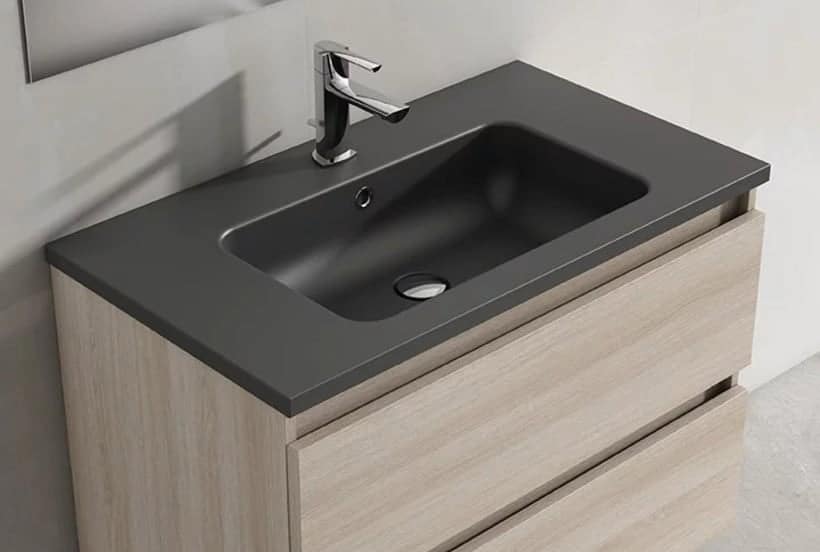
When the basin and countertop are blended into one piece, it offers a smooth, contemporary look. These integrated sinks, or countertop basins, are popular because they offer several advantages over traditional sinks.
Firstly, the seamless design of integrated sinks eliminates the need for a separate installation, making the overall installation process simpler and more efficient. This also means that there are no gaps or joints where dirt and grime can accumulate, making cleaning and maintenance much easier.
They can also be customised in size and shape, creating a unique focal point in any bathroom. Whether you’re going for a minimalistic, rustic, or luxurious vibe, there’s an integrated sink that can perfectly complement your bathroom decor.
Lastly, integrating the basin and countertop allows for more countertop space, providing additional room for storage or other activities. Overall, the popularity of integrated sinks can be attributed to their seamless design, ease of installation and maintenance, aesthetic appeal, and practicality.
Semi-recessed Sinks: Comfort and Accessibility
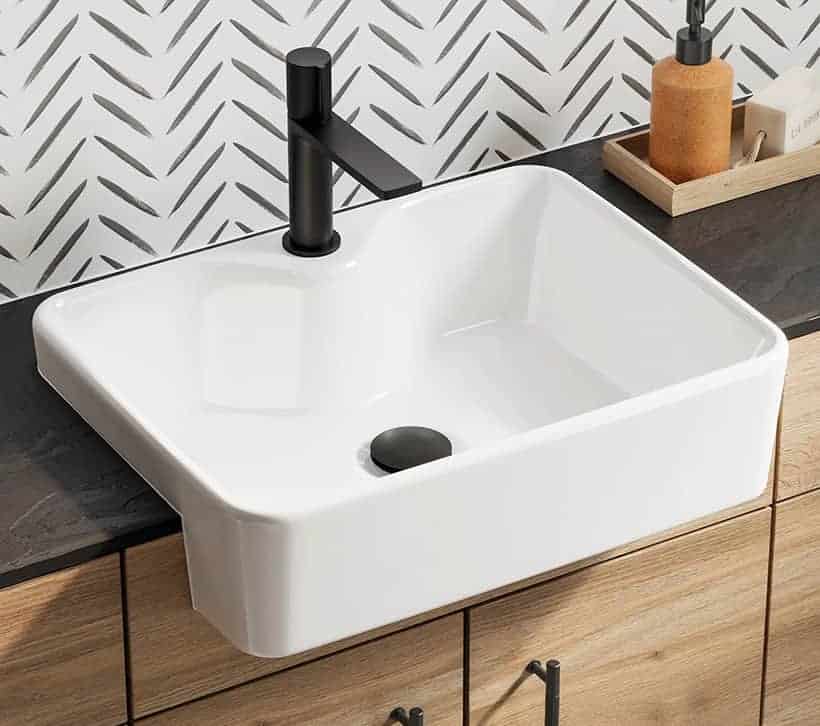
The semi-recessed sink is a versatile solution with its partial protrusion from the counter. Especially suitable for children’s bathrooms or spaces where accessibility is essential.
Semi-recessed sinks offer both comfort and accessibility due to their unique design. The sink is partially recessed into the countertop, which creates a lowered front edge. This design feature allows easy access, making it ideal for children or individuals with mobility limitations.
The lowered front edge makes it easier for users to reach the faucet and wash their hands comfortably. And the semi-recessed sinks can be installed at a height suitable for the user, further enhancing accessibility.
Also, the protruded edge prevents water from dripping onto the cabinet below, eliminating the possibility of water seeping into the cabinet or drawer.
Overall, these sinks provide a practical and convenient solution for bathrooms catering to different users’ needs.
Understanding the Pros and Cons of Bathroom Basin Materials
Choosing the perfect bathroom basin involves understanding the materials they’re made from. This knowledge is vital as it influences the aesthetics and your basin’s durability and maintenance requirements.
This section delves into different materials such as ceramic, glass, stone, metal, and acrylic, discussing their advantages and disadvantages.
Whether you’re drawn towards the classic elegance of ceramic basins, the contemporary style of glass, or the natural charm of stone, understanding the pros and cons of these materials will help you make an informed decision.
Ceramic
Ceramics are known for their classic and timeless appeal. They add a whisper of deluxe comfort to any bathroom design, whether it is modern or traditional. The versatility of ceramic material allows for a wide range of basin shapes and sizes, making it easy to find the perfect basin to suit your specific needs and preferences.
In terms of durability, the ceramic basin is hardwearing and resistant to scratches, stains, and heat. This makes them ideal for everyday use in busy bathrooms. They are also easy to clean and maintain, requiring only a simple wipe-down with a mild cleaner to keep them looking pristine.
However, on the flip side, ceramic basins may be more prone to chipping or cracking compared to other materials like stone or resin. While ceramic is durable, it is not completely immune to damage from heavy impacts or accidental drops. Therefore, it is important to handle ceramic basins with care and avoid placing heavy objects on them.
Another aspect to consider is the price range of ceramic basins. While they can be more affordable than luxury materials like marble or granite, high-end ceramic basins can still be expensive. The price may vary depending on the brand, design, size, and additional features like integrated overflow or tap holes.
Tempered Glass
Glass basins are not only visually appealing but also highly functional. They are easy to clean and maintain, making them a practical choice for any bathroom. The smooth surface and sleek design create a modern and luxurious look that can instantly elevate the overall aesthetic of your bathroom.
Whether you have a minimalist or a more extravagant style, glass basins can effortlessly stir some poshness to your bathroom decor. With their timeless appeal and durability, glass sinks are a perfect choice for those seeking to create a sophisticated and stylish bathroom ambience.
But like ceramic or porcelain, glass can chip and crack. However, it would require a high-impact force to cause the damage.
If you need a reason to disqualify glass as a basin material, it’s probably the transparency that needs a higher frequency of cleaning and wiping. Or else the water stains and smudges in or underneath the basin will be an eyesore in no time. Then again, there’s always the frosted glass option.
For those who prefer low-maintenance bathroom fixtures, glass basins can be a hassle to maintain their pristine appearance despite their easy-to-clean smooth surfaces.
Natural Stone
Natural stone basins are a testament to nobility and durability. They are crafted from natural materials such as marble, granite, or travertine, ensuring their longevity and timeless appeal. The unique patterns and textures found in stones entwine a trace of splendour to any bathroom or washroom space.
With their smooth surfaces and contemporary designs, stone basins not only provide a functional element, they are frequently made a statement piece in the room. Whether you prefer a purist and neoteric look or a more traditional aesthetic, a stone basin suits every style and preference.
Additionally, the excellent durability of these basins ensures that they can withstand daily use and maintain their beauty for years to come, making them a worthwhile investment for any homeowner.
The drawbacks of stone are that it can be quite heavy, which may require additional support during installation. Stone basins can also be more expensive than other materials, such as ceramic or porcelain.
Additionally, natural stone may require regular maintenance and sealing to prevent permanent staining or damage. And the cost may put you off if the budget needs a constant watch to keep it intact.
Composite Stone
Composite stone, engineered stone, or quartz composite, is created by combining natural stone aggregates, typically quartz or marble, with a resin binder. This mixture results in a highly durable and versatile product, often with the aesthetic appeal of natural stone but with enhanced properties. It is becoming increasingly popular as a bathroom basin material in recent years.
One of the primary reasons is its robust nature. Combining natural stone particles with resins produces a material resistant to stains, scratches, and even some chemicals. This makes composite stone basins easy to clean and maintain, adding to their appeal for busy households.
Furthermore, the flexibility in its manufacturing allows for a variety of colours, patterns, and finishes. Whether homeowners are looking for a minimalist, contemporary design or a more traditional appearance, composite stone can deliver.
Additionally, its non-porous nature means it is hygienic and resistant to bacteria and mould, a vital feature for bathroom environments. In the UK, where temperature fluctuations can be significant, the thermal resistance of composite stone is another beneficial property, ensuring longevity in both look and functionality.
However, composite stone can be considerably heavy due to its dense composition. This might require additional structural support, especially for larger basins or countertops. Also, they are not completely heatproof.
While composite stone exhibits decent thermal resistance, it’s not entirely impervious to heat. So be mindful not to place the hairdryer or curling iron while it’s still hot directly on the stone surface; it may result in discolouration or damage.
Acrylic
Acrylic basins are made of solid plastic and usually reinforced with fibreglass and resin, providing a lightweight and cost-effective alternative to other sink materials. With acrylic’s moldable properties, it opens up a range of design possibilities, lending itself to a spectrum of styles.
Due to its lighter-duty nature, acrylic sinks are apt for any bathroom setting. They have the advantage of being easy to maintain, provided they aren’t subjected to sharp objects, abrasive sponges and harsh cleaners.
Another drawback of Acrylic sinks is that they are not built to withstand high temperatures. Leaving a hot curling iron or hairdryer on your bathroom sink could potentially ruin its smooth surfaces.
Although acrylic has sound-absorbing properties, as some websites suggest, the effect of reduced sound levels in the bathroom is insignificant. If noise is a concern, you will need more sound-absorbing materials in the bathroom than just a basin to control noise.
When it comes to the merits of acrylic bathroom sinks, their affordability stands out. They also possess antibacterial and antimicrobial properties, making them a hygienic choice. Their non-porous surface helps resist stains, and their adaptability to various forms enables a range of stylish designs.
But it’s not all sunshine with acrylic sinks. They might not be as durable as their counterparts made of more robust materials. Their vulnerability to heat is a point to be mindful of when considering an acrylic bathroom sink.
Stainless Steel
Stainless steel, traditionally more recognised for its extensive use in kitchen basins, is increasingly finding its place in UK bathrooms as a basin material. Its prominence in the kitchen is owing to its durability and ability to withstand various kitchen activities. However, in the contemporary UK home, homeowners recognise the unique appeal and benefits it can bring to the bathroom environment.
One of stainless steel’s primary advantages is its strong and long-lasting nature. This material is incredibly durable and resistant to corrosion, ensuring longevity even in the moist atmosphere of a bathroom. Moreover, it’s non-porous, which means it doesn’t harbour bacteria. This attribute aligns well with the hygienic requirements of bathroom space.
Cleaning and maintenance of stainless steel basins are generally straightforward, requiring just a simple wipe down with a damp cloth and a mild cleaner to retain its shine.
Stainless steel also offers a unique aesthetic that differentiates it from conventional bathroom basin materials. While it might carry a more industrial aura, innovative manufacturing techniques now enable it to be moulded into various shapes and designs, catering to modern and traditional bathroom decors.
However, stainless steel is not without its challenges when used as a bathroom basin material. For one, it can be prone to showing water spots and stains, requiring frequent cleaning to keep it looking its best.
There’s also a potential for it to be dented or scratched if exposed to hard or sharp objects, which might be less of an issue in a bathroom than a kitchen but is still worth noting.
And besides it being durable, over time and with consistent exposure to hard water or aggressive cleaning agents, it might lose its shine or develop minor discolourations.
While stainless steel might be a less conventional choice for bathroom basins compared to its established role in kitchens, it offers a unique combination of durability, hygiene, and design versatility. Homeowners seeking a durable and distinct basin option might find stainless steel a worthy contender, provided they are mindful of its few caveats.
Copper
While it’s not the most conventional choice for a bathroom basin, copper carries a character and warmth that few materials can replicate. Its distinctive appearance brings a sense of history and artistry, making it an ideal option for designing bathrooms with a unique flair.
One of the noteworthy attributes of copper as a basin material is its antimicrobial properties. This natural characteristic means bacteria and viruses don’t survive long on its surface, promoting a more hygienic bathroom environment.
Over time, copper also develops a patina, a natural film that forms on the surface due to oxidation. This patina adds a layer of protection against corrosion and transforms the basin’s appearance over time, offering a dynamic and evolving aesthetic.
However, using copper as a bathroom basin material has its challenges. The very patina, which many admire for its evolving beauty, can be seen as a disadvantage by others who prefer a consistent look. The rate and pattern of this patina formation can be unpredictable, sometimes leading to uneven colourations. While many appreciate the ever-changing character of a copper basin, others might find it less appealing.
There’s also the matter of cost. Authentic copper basins often come with a higher price tag, a reflection of the craftsmanship and quality of material involved. Hence, it’s an investment that one would need to consider carefully.
Maintaining a copper basin, contrary to popular belief, is relatively straightforward. Mild soap and water are typically sufficient for routine cleaning, and its natural tarnish ensures it remains rust-free.
Last but not least, copper presents itself as a fascinating choice for bathroom basins, boasting both aesthetic allure and functional benefits. Yet, as with any material, understanding its quirks and requirements is essential for those considering it.
While it might not cater to everyone’s taste or budget, copper offers a bathroom experience like no other for those drawn to its unique character.
Factors to Consider When Choosing a Bathroom Basin
Choosing the right bathroom basin is not just about aesthetics; it’s also about functionality, space, and matching the overall design of your bathroom. With the vast range of styles, materials, and designs, selecting the perfect one can be daunting.
Here’s a guide outlining essential factors to help you make an informed decision and avoid feeling overwhelmed.
Assessing Bathroom Space and Size
- Overall Space: The size of your bathroom plays a significant role. A wall-mounted or compact basin or corner sink may be ideal if you have a smaller bathroom or a cloakroom. In contrast, larger bathrooms can accommodate bigger or double basins.
- Positioning: Think about where the basin will sit. Will it be near a door, next to a shower, or under a window? Ensure there’s enough space to move around once it’s installed.
Plumbing Considerations
- Existing Plumbing: The current setup might dictate the type of basin you can install. Moving plumbing around can be costly, so if you’re on a budget, choose a basin that fits with the existing plumbing.
- Tap Placement: Some basins come with pre-drilled tap holes, while others require wall-mounted taps. Ensure the basin you choose matches your tap placement preference.
Matching Your Basin with Bathroom Decor
- Style: Your basin should complement the overall style of your bathroom. A vintage-styled bathroom might benefit from a traditional pedestal basin. In contrast, a modern bathroom with a countertop or undermount basin might look best.
- Colour and Finish: With the variety of materials available, basins can come in different colours and finishes. Whether you prefer glossy or matte, neutral or bold, ensure the basin’s tone matches or complements your bathroom’s colour scheme.
Evaluating Basin Durability and Maintenance
- Material: The material of the basin will dictate its longevity and maintenance requirements. For instance, ceramic is durable and easy to clean, while materials like natural stone might require more care.
- Usage: If the bathroom will see heavy use, perhaps by a large family, consider a basin material resistant to scratches and chips.
Budgeting for Your Basin
- Set a Budget: Basins come in a wide range of prices. Before shopping, set a clear budget to help narrow down your choices.
- Factor in Additional Costs: The price of the basin may not include taps, wastes, or potential installation costs. Make sure you account for these additional expenses.
Functionality and Features
- Storage Needs: If storage is crucial, consider a basin that comes with a vanity unit. This provides extra space for toiletries and other bathroom essentials.
- Depth and Width: A shallow basin might be stylish but consider its practicality. Will it cause water to splash? If so, a deeper design might be more appropriate.
Environmental Concerns
- Water Usage: Some basins have features that reduce water flow or designs requiring less water. If conservation is a priority, look for these eco-friendly models.
While the design and appearance of a bathroom basin are undeniably important, practical considerations should be at the forefront of your decision-making process. Balancing aesthetics with functionality and budget constraints allows you to breeze through the wide selection without feeling overwhelmed.
Caring for Your Bathroom Basin
The bathroom basin, often seen as the centrepiece of the room, is subject to frequent use. Ensuring its cleanliness and longevity requires regular maintenance, the right cleaning techniques, and a bit of foresight to avoid damage. Let’s delve into how you can care for your basin, keeping it in pristine condition for years.
Regular Maintenance and Cleaning Tips
A regularly cleaned basin doesn’t just look good; it also offers a more hygienic environment. Start with a simple routine. After use, rinse the basin with clean water to remove soap, toothpaste, or any other residue. This quick rinse prevents the build-up of grime and makes deeper cleaning sessions easier.
Use a soft cloth or sponge with mild soap or a gentle bathroom cleaner for a more thorough cleaning. These agents effectively remove any accumulated dirt without harming the basin’s surface. Remember, abrasive cleaners or scrubbers can leave scratches, especially on delicate materials like ceramic or porcelain.
Water spots can be a common issue, primarily if you have hard water. Combat this by regularly wiping down your basin with a dry cloth afterwards. A mixture of equal parts white vinegar and water can be effective for more stubborn water stains. Gently rub the solution on the stain, let it sit for a few minutes, and rinse off.
Avoiding Common Basin Damages
Accidents happen, but you can avoid the most common basin damages with some caution. Refrain from dropping heavy objects like glass containers or tools into the basin. Such incidents can cause chipping or even cracks.
Be wary of extreme temperature changes. Pouring boiling water directly into a cold basin can lead to thermal shock, potentially causing the material to crack. If you need to dispose of hot water, let it cool down slightly or mix it with cold water before pouring.
Cosmetic products, hair dyes, and certain medications can stain your basin. To avoid this, always wipe off any spills immediately and rinse the basin thoroughly after using such products.
Extending the Lifespan of Your Basin
Regular maintenance plays a pivotal role in extending your basin’s lifespan. Still, there are other things you can do to ensure your basin remains in top condition for longer.
Ensure all fittings, like taps and drains, are installed correctly. Leaking taps can lead to persistent water exposure, which might degrade certain basin materials over time. Address any plumbing issues promptly.
Sealing, especially for natural stone basins, can be a game-changer. A proper sealant protects the basin from stains and potential erosion, especially from acidic or abrasive substances.
Investing in good-quality basin plugs and strainers can prevent unwanted debris from going down the drain. This helps maintain a clog-free drainage system and ensures that harmful substances don’t come into prolonged contact with your basin’s surface.
In essence, caring for your bathroom wash basin is a blend of regular cleaning, preventive measures, and thoughtful usage. Adopting these practices ensures that your basin remains a shining jewel in your bathroom, marrying functionality with aesthetics seamlessly.
Taps: Choosing the Right Fit for Your Basin
Finally, don’t forget the most crucial component among the basin accessories, the basin tap, to go with your selected basin. And like the basin, you are never short of choices from the endless range of basin taps.
Taps, often an afterthought in bathroom design, play a pivotal role in enhancing the functionality and aesthetics of your bathroom basin. A compatible basin tap can accentuate your basin’s design, ensure efficient water flow, and even contribute to water conservation.
Let’s delve briefly into the considerations for selecting the most fitting tap for your basin:
1. Tap Holes and Configuration: Depending on the design of your basin, there might be pre-drilled holes for taps. Some basins come with a single tap hole suitable for mixer taps, which combine hot and cold water. In contrast, others have two holes for individual hot and cold taps. Additionally, there are basins with no tap holes, designed exclusively for wall-mounted or floor-standing taps.
2. Style and Design: The array of tap designs available can be overwhelming. From traditional pillar taps and contemporary basin mixers to chic wall-mounted or freestanding models, your choice should resonate with the basin design and the broader aesthetic of your bathroom. For example, a vessel or bowl-shaped basin might pair well with a tall, freestanding tap. In contrast, a compact round or square basin may benefit from a wall-mounted tap to save on counter space.
3. Water Pressure: It’s essential to ensure your selected tap is compatible with your home’s water pressure. While some taps operate efficiently on low pressure, others might require higher pressure systems. Ensuring compatibility guarantees optimal water flow and prevents potential dripping or leaking issues.
4. Material and Finish: Taps come in various materials and finishes, from chrome, brass, and stainless steel, to matte black or brushed nickel. Your choice should match your bathroom’s basin and other fixtures and fittings for a cohesive look. Moreover, consider the longevity and maintenance requirements of the tap material.
5. Water Efficiency: With increasing awareness of water conservation, many modern taps come with water-saving features, such as aerators or flow limiters. These features can reduce water wastage, offering an eco-friendly option without compromising performance.
6. Temperature Control and Safety: For households with children or elderly members, consider taps with thermostatic controls. These taps ensure a steady water temperature, preventing accidental scalding. Some also come with anti-scald features, which automatically shut off when the water reaches a certain temperature.
7. Ease of Operation: Consider the tap’s mechanism, especially if the bathroom will be used by individuals with mobility issues. Lever taps, for instance, can be operated with one hand, while push-button taps can be more intuitive for some users.
8. Bathroom Basin Wastes: Which is the right choice, slotted or unslotted basin Waste? This factor hinges on whether your basin has an overflow or not. If it does, a slotted waste is necessary, allowing excess water to drain away. If there’s no overflow, unslotted waste will suffice.
Taps, though small, can significantly impact the look and functionality of your bathroom basin. By paying attention to tap considerations, you can ensure a harmonious blend of style, functionality, and durability in your bathroom space.
Summary
Choosing the ideal bathroom basin involves more than aesthetics; it requires a comprehensive understanding of functionality, space, and complementary accessories like taps.
When selecting a basin, space is paramount. The size and design of your bathroom can dictate whether you opt for wall-mounted, countertop, vanity or corner basins. Each type offers distinct advantages, some freeing up floor space and others providing additional storage.
The plumbing setup is equally crucial. While some basins, such as wall-mounted varieties, demand concealed plumbing, others, like pedestal basins, conveniently hide pipework.
Meanwhile, basins come in varied materials like ceramic, stainless steel, and stone, each presenting its own aesthetic and durability. Stone, for instance, imparts a natural and durable aspect, while ceramics are lauded for easy maintenance.
Taps, often undervalued, play a pivotal role in basin functionality and design. Basins may come with pre-drilled holes to accommodate certain tap types, or none, suited for wall-mounted taps. Taps vary from traditional to contemporary designs, and their choice should harmonise with the basin and the overarching bathroom theme.
Moreover, compatibility with home water pressure, material choice, water efficiency, and safety features are vital tap considerations. For instance, some taps are designed with water-saving features. In contrast, others have safety mechanisms to prevent accidental scalding, which is crucial for homes with children or older people.
In conclusion, the perfect bathroom basin blends space suitability, design coherence, material durability, and compatibility with complementary fixtures like taps. Such a holistic approach ensures that the basin is a visual centrepiece and a functional and durable bathroom component.

